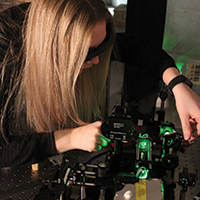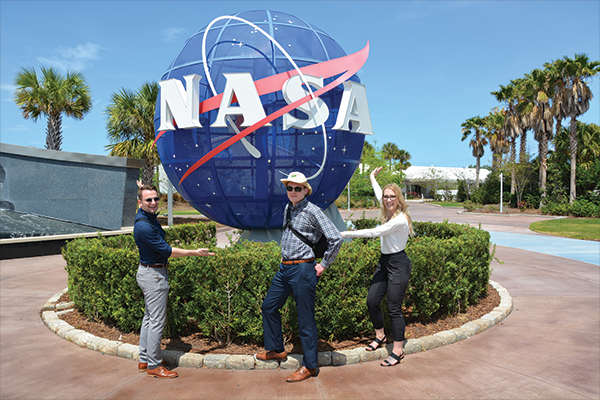
Kristen Cote in the University of Alberta's Astronomical Observatory.
To start, measure out equal parts pure and applied science. Add a splash of laser-cooled atoms and one cube satellite. Shake well to combine. Chill for four long Edmonton winters, and serve with a generous helping of get-up-and-go.
Kristen Cote's ('16 BSc) postsecondary philosophy is simple-"Your degree is what you make it, so if you see something that's interesting, then just go do it."
Born and raised in Edmonton, the 24-year-old never questioned which university she wanted to attend. "When you have a world-class university in your city, you take advantage of that and live with your parents for four years," she says. "I didn't apply anywhere else. U of A was my top choice."
Cote sees the world of space science as her proverbial oyster, leaping nimbly over any barriers encountered throughout her journey in the male-dominated STEM fields. "I never thought I couldn't do it. I wanted to do cool stuff so I did. I didn't care about what people thought of me or anything else."
Though choosing which university to attend was easy, Cote was torn on whether to pursue hard science in the form of a physics degree, or go for a more applied route with engineering. In the end, science won out, but she kept her schedule packed with extra projects and activities to ensure she still got the best of both worlds- projects like AlbertaSat.

While Ex-Alta 1 continues to orbit Earth collecting data about space weather, the AlbertaSat team is now working on its second cube satellite mission. Ex-Alta 2 will help combat forest fires, thanks to funding of $250,000 from the Canadian Space Agency, announced in May.
Alberta's first satellite
Working alongside more than 40 other undergraduate and graduate students, and with a few faculty advisers, Cote helped to build and launch Alberta's first satellite into space-the Experimental Albertan 1, or Ex Alta-1.
The student-built cube satellite has been orbiting Earth since spring 2017, measuring electron temperature and the density of the plasma surrounding Earth as part of the QB50 mission. Cote still considers her AlbertaSat work her greatest achievement.
"Literally, as almost a child-well, not a child but an 18-year-old, and feeling like a child-I got to participate in building a satellite with a bunch of other enthusiastic young adults and actually launch it . . . and that's insane," says Cote.
"I still have AlbertaSat stickers all over my laptop. I can't stop talking about it. It's the best thing I've ever been involved with."
"I think both that research and AlbertaSat, in a way even though they're both different and separate, moulded what I'm doing right now. I have become passionate about investigating new techniques in optical science and instrumentation that can be used to explore the universe."
The experience was one of several Cote pursued alongside her degree, which also included an honors thesis in quantum optics with Lindsay Leblanc, assistant professor of physics and Canada Research Chair in ultracold gases for quantum simulation. "I think both that research and AlbertaSat, in a way even though they're both different and separate, moulded what I'm doing right now. I have become passionate about investigating new techniques in optical science and instrumentation that can be used to explore the universe."
The next phase
Cote is now wrapping up her master's degree at York University (Toronto), collaborating with a mix of engineers, physicists, and geologists in the planetary instrumentation lab to explore new instruments for future space missions to other planets, asteroids, or planetary bodies.
After that, she'll embark on her PhD. After being accepted to programs at the California Institute of Technology (Caltech), the University of Colorado Boulder, and the University of Cambridge, Cote has decided on the University of Toronto.
"UToronto is internationally recognized for excellence in physics and is the hub of the Canadian space industry," explains Cote. "Another major benefit is the ability to dig into research right away; we're lucky in Canada that students are trusted to jump into researching what they're passionate about from the moment they start."
Her research will focus on gravitational wave detection, developing compact optical atomic clocks that could one day be used in space to detect things farther out in the universe than currently possible.
"It's a new era-we've entered an age of 'multi-messenger' astronomy. By detecting gravitational waves in space, we'll be able to see farther than we've ever seen before in the universe, and then we can hopefully answer some really important questions, like, 'Has the shape of the universe changed over time?' and 'What is the future of our universe?' "
"Getting my PhD is the next big step, and then hopefully I can help increase Canadian involvement in space exploration."
No matter how deep into space her attention is focused, however, Cote won't soon forget her roots.
"Getting my PhD is the next big step, and then hopefully I can help increase Canadian involvement in space exploration," she says. "Canada is great. Canadian scientists and engineers are great, and I think we need to be more involved in space. And I definitely want to be part of that."
